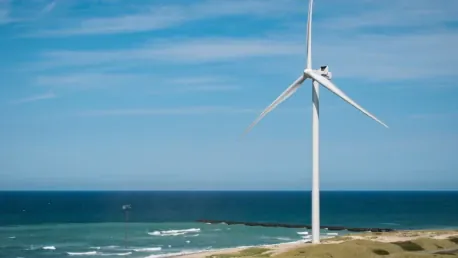The Empire Wind 1 project is a groundbreaking offshore wind initiative that aims to transform New York City’s (NYC) energy landscape. Managed by Equinor and backed by a $3 billion investment, this ambitious endeavor targets providing electricity to half a million households by 2027 by harnessing the power of renewable energy. As NYC strives to lower its environmental footprint and diminish its reliance on fossil fuels and nuclear power, the project underscores both significant advancements and notable challenges in the realm of sustainable energy. Amid ongoing discussions on climate change and sustainability, the Empire Wind 1 project is poised to play a critical role in leading America toward renewable energy sources.
A Major Step Towards Renewable Energy Adoption
The Empire Wind 1 project represents a significant leap toward renewable energy adoption in NYC. Once operational, this initiative will crucially support the city’s energy grid by potentially reducing reliance on traditional fossil fuels and nuclear power. This is particularly important as NYC aims to diminish air pollution, greenhouse gas emissions, and overall dependency on environmentally harmful energy sources. However, it is essential to note that the high costs associated with offshore wind energy pose substantial financial challenges, especially in the U.S. The critical metric for assessing the viability of energy projects like this is the levelized cost of energy (LCoE), which measures the average cost of electricity generation over the project’s lifespan.
The LCoE for various energy sources varies significantly, with utility-scale solar and land-based wind projects typically ranging from $20 to $50 per megawatt-hour (MWh). In contrast, natural gas plants tend to have an LCoE between $45 and $80/MWh. These figures serve as a basis for understanding the economic challenges associated with different forms of energy, reflecting the costs related to construction, maintenance, and financing. By comparing these figures, stakeholders can assess the economic feasibility and potential impact of switching to renewable energy sources like offshore wind.
Financial Challenges and Comparisons
Despite the promising outlook for renewable energy, the Empire Wind 1 project faces considerable financial challenges. As of 2023, the global average LCoE for offshore wind is $75/MWh, but this figure shows significant regional variations. For instance, China averages $65.7/MWh, the UK around $50/MWh, and countries like Germany, Denmark, and the Netherlands report costs near $84/MWh. Notably, the U.S. faces higher costs at approximately $89.33/MWh. Empire Wind 1’s projected costs significantly exceed these averages, highlighting the unique challenges of constructing and maintaining offshore wind farms in more demanding environments.
Equinor, the project developer, has secured a 25-year contract with the New York State Energy Research and Development Authority (NYSERDA) to deliver electricity at $155/MWh. This price nearly doubles the national average LCoE for offshore wind, reflecting the additional challenges posed by exposure to severe weather and saltwater corrosion, which can reduce the lifespan of equipment. Despite these financial hurdles, Empire Wind 1 remains a critical milestone for NYC’s energy transition. Spanning 80,000 acres and located 15 miles from Long Island, the project has the capacity to produce up to 810 megawatts (MW) of power, fulfilling approximately 6% of the city’s annual 53 terawatt-hour energy demand.
Potential Impact on Consumer Costs and Energy Supply
The transition to renewable energy sources like offshore wind can potentially lower electricity costs for NYC residents, who currently pay around $0.31 per kilowatt-hour (kWh). Under optimal conditions, the Empire Wind 1 project could reduce this cost to $0.15/kWh, although consumer savings are not guaranteed. Closing the Indian Point nuclear plant recently created a gap in NYC’s energy supply, which has been largely filled by natural gas plants, such as Ravenswood and Astoria. These facilities contribute to air pollution and greenhouse gas emissions, leading to a pressing need for cleaner alternatives.
Offshore wind energy provides a cleaner alternative, though it raises concerns about its impact on marine ecosystems. Interestingly, wind farms can create refuges for marine life, even as they restrict commercial fishing activities in their vicinity. The adoption of offshore wind energy in the U.S. has been slower compared to other nations, primarily due to regulatory complexities and higher costs. Currently, only three offshore wind farms are operational nationwide. However, with projects like Empire Wind 1 underway, future ventures’ costs are expected to decline, fostering broader use of sustainable energy and setting a precedent for similar initiatives.
Economic and Environmental Benefits
The Empire Wind 1 project, a pioneering offshore wind initiative, aims to revolutionize New York City’s (NYC) energy sector. Overseen by Equinor and supported by a $3 billion investment, this ambitious project seeks to deliver electricity to half a million households by 2027 using renewable energy. NYC is committed to reducing its carbon footprint and dependency on fossil fuels and nuclear energy, making this venture crucial for its environmental goals. The Empire Wind 1 initiative not only highlights significant progress in sustainable energy but also acknowledges the considerable challenges that come with such transformations. In the broader context of climate change and sustainability discussions, this project is set to play a pivotal role in propelling America toward a greener future, emphasizing the importance of renewable energy sources. With ongoing investments and technological advancements, the Empire Wind 1 project stands as a beacon of hope, underscoring the necessity of transitioning to cleaner energy to ensure a sustainable and prosperous future for upcoming generations.









